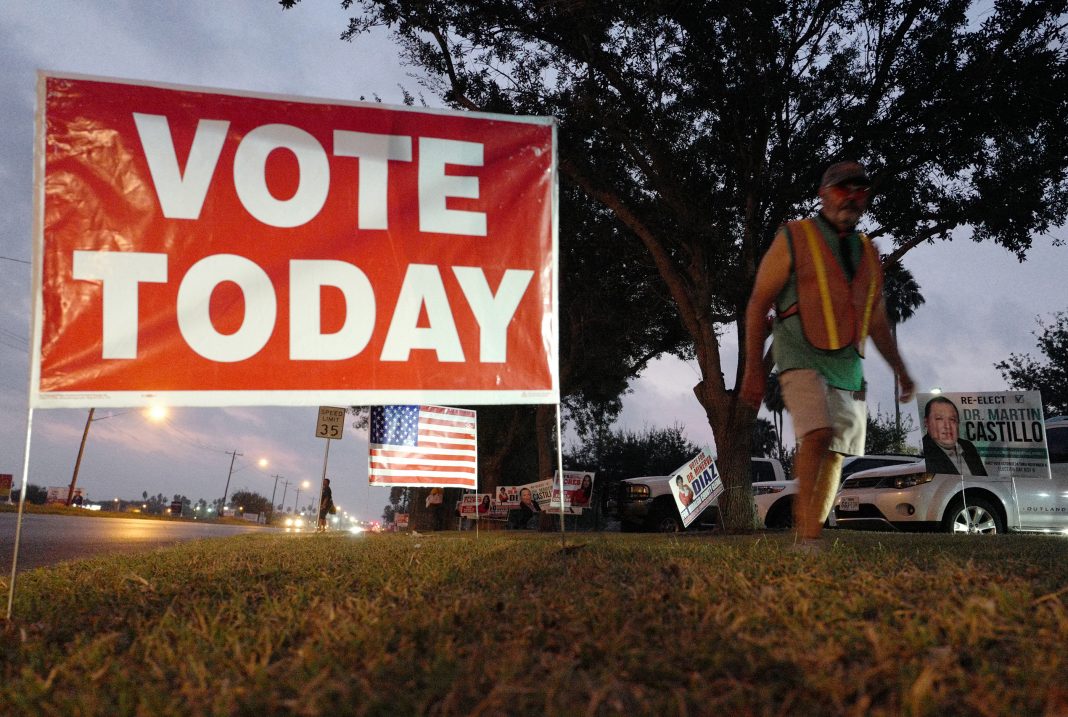Voter participation across the Rio Grande Valley improved in the second week of early voting but still fell short of reaching the statewide average.
“It’s definitely improved, but it’s still behind turnout from 2018,” Derek Ryan, a Republican data analyst said Saturday as he looked over unofficial early voting data.
Out of all the Valley counties, Starr County voters turned out the most, with about 27.2% casting their ballots or sending them in by mail. Hidalgo County saw about 24.93%, Cameron County came in close with 24.06% and Willacy County followed with about 15.16%, according to data from the Texas Secretary of State’s Office.
Turnout lagged nearly every day of early voting compared to its respective day in 2018.
Friday was the exception statewide and in some parts of the Valley.
“I have us sitting at about 5.5 million votes cast through yesterday, and in fact, statewide, about 720,000 people voted yesterday alone,” Ryan said about Friday’s early vote tallies. “So that was the largest day of early voting during the two-week period.”
Cameron County voters finished the week strong with over 7,500 people going out to vote. That represented about 3.32% of registered voters. It was much higher than the last day of early voting in 2018 when about 2.96% of registered voters, or 6,100 people, went out to the polls.
Hidalgo County also had a large turnout on Friday, with nearly 15,400 people voting in-person, compared to about 13,650 the same day in 2018. However, the number did not surpass the total number of registered voters: 3.72% this year compared to 3.81% in 2018.
“We only have one weekend of early voting,” Dr. Alvaro Corral, an assistant professor at the University of Texas Rio Grande Valley’s political science department, said Saturday. “I think all those elevated numbers on Friday are because everyone’s like, ‘Oh, gosh, it’s the last day I can go. And I really don’t want to face the lines on Tuesday.’ So I’m probably not surprised by that.”
This year’s turnout, when compared to the 2018 midterm election numbers, continues to underwhelm analysts who now see 2018, which had a gubernatorial race and a U.S. senate race on the ballot, as more of an outlier.
“I probably guess that the one with the two big races would have a higher turnout, and I think we’re gonna probably see that. So maybe it’s not all that surprising,” Corral said.
So far, data analysts who are analyzing voter history calculate that Republicans have an advantage.
Ryan, a Republican analyst, found that about 40% of early voters have a Republican primary history, while those who have historically voted in the Democratic primaries only made up about 29% of the early votes by Friday.
A Democratic data analyst report by TargetSmart arrived at a similar outcome, with about 44% of likely Republicans comprising early votes in Texas and only 40.3% of likely Democratic voters casting their ballots. Their methodology differs from Ryan, who looks at previous primary voting history. TargetSmart, however, employs other data points to help determine a voter’s party leaning.
“It seems like Republican primary voters still have an edge of about 560,000 votes statewide over people that have Democratic primary history,” Ryan said Saturday.
Higher engagement was also found among voters 50 years of age and higher, as opposed to those between 18 and 49 years old.
Younger voters tend to skew to the left, while Republican voters tend to be older, consultants said.
“Only 14% of voters aged 18 to 29 have voted. And for comparison, in 2018, 34% voted,” Ryan pointed out.
Independent or unaffiliated voters may help decide the race, but Corral predicted they may favor the GOP.
“I think that probably favors Republicans too,” Corral said.
Some of the most competitive races around the country are focused on the Valley, including the congressional races in Starr, Hidalgo and Cameron counties. But so far, Hispanics have not outperformed 2018 numbers.
Ryan’s data focused on voters with Hispanic surnames and found that only about 21% of the demographic voted early.
“That’s actually half of what it was for the entirety of the 2018 general election,” Ryan said. “After election day in 2018, 42% of voters with a Hispanic surname voted. So, in order to reach out this cycle, we’re going to have to see large numbers from the Hispanic community on election day as well.”
Party leaders from both sides will be mounting last-ditch efforts next week, including a visit by President Bill Clinton and top national Republican leaders to motivate more people to head to the polls.





